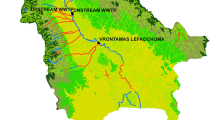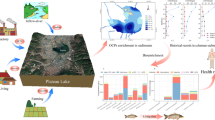Abstract
Samples of pond sediment, fish, and shrimp were collected from the Ramsar site at Mai Po marshes, Hong Kong (south China), and samples of pond sediment, fish, and shrimp, as well as eggs of water birds (Chinese Pond Herons (Ardeola bacchus) and Little Egrets (Egretta garzetta)), were collected from two smaller wetland sites at Jiangsu Province (mid-China), between 2004 and 2007. Accumulation levels of polycyclic aromatic hydrocarbons (PAHs) and organochlorine pesticides (OCPs) in the biota were used to calculate biota–sediment accumulation factor (BSAF) and bioaccumulation factor (BAF). For fish and shrimp, BSAFs of OCPs (3.8–56) were greater than those of PAHs (0.12–6.3). BSAFs and BAFs of 11–79 and 4–34, respectively, were registered for OCPs in eggs of the birds and were greater than those for PAHs (0.11–1.5 and 0.02–1.3, respectively). Assuming that fish were the main prey of the birds, greater bioaccumulation of OCPs was detected for both bird species (BAFs = 4.5–34), while accumulation of PAHs was only detected in Little Egret (BAF = 1.3). A significant linear relationship (p < 0.01) was observed between concentrations of OCPs in bird eggs and in the prey fish. The present study provides a new possibility of using OCP levels detected in prey fish to predict the extent of OCPs contamination in eggs of waterbirds including the endangered species, as a noninvasive method.



Similar content being viewed by others
References
Adeniyi AA, Yusuf KA, Okedeyi OO (2008) Assessment of the exposure of two fish species to metals pollution in the Ogun river catchments, Ketu, Lagos, Nigeria. Environ Monit Assess 137:451–458
Agriculture, Fisheries and Conservation Department (2011) Mai Po Inner Deep Bay Ramsar Site Management Plan. AFCD, Hong Kong, China
Albers PH (2006) Birds and polycyclic aromatic hydrocarbons. Avian Poult Biol Rev 17:125–140
Antoniadou V, Konstantinou IK, Goutner V, Sakellarides TM, Albanis TA, Bintoudi E (2007) PCB levels and accumulation pattern in waterbird eggs and in their prey at Lake Kerkini, a northeastern Mediterranean wetland of importance. Arch Environ Contam Toxicol 53:249–260
Boyd CE, Tanner ME, Madkour M, Masuda K (1994) Chemical characteristics of bottom soils from freshwater and brackish-water aquaculture ponds. J World Aquacult Soc 25:517–534
Burkhard LP, Lukasewycz MT (2000) Some bioaccumulation factors and biota–sediment accumulation factor in polycyclic aromatic hydrocarbons in lake trout. Environ Toxicol Chem 19:1427–1429
Connell DW, Fung CN, Minh TB, Tanabe S, Lam PKS, Wong BSF, Lam BHW, Wong LC, Wu RSS, Richardson BJ (2003) Risk to breeding success of fish-eating Ardeids due to persistent organic contaminants in Hong Kong: evidence from organochlorine compounds in eggs. Water Res 37:459–467
Department of Environmental Quality, Louisiana, 2003. http://www.deq.louisiana.gov/portal/Portals/0/technology/recap/2003/RECAP%202003%20Appendix%20I%20Tables%2017,18,%20Worksheets%201-8.pdf.
Dong YH, An Q, Gong Z, Wang H (2002) Bioindication of organochlorine pesticides by night heron in Taihu wetland ecosystem. Chin J Appl Ecol 13:209–212
Dong YH, Wang H, An Q, Ruiz X, Fasola M, Zhang YM (2004) Residues of organochlorinated pesticides in eggs of water birds from Tai Lake in China. Environ Geochem Health 26:259–268
FishBase (2013). http://www.fishbase.org/search.php
Furness RW (1993) Birds as monitors of pollutants. In: Furness RW, Greenwood JJD (eds) Birds as Monitors of Environmental Change. Champman Hall, London, UK, pp 86–143
Kong KY, Cheung KC, Wong CKC, Wong MH (2005) The residual dynamic of polycyclic aromatic hydrocarbons and organochlorine pesticides in fishponds of the Pearl River Delta, South China. Water Res 39:1831–1843
Lam JCW, Kajiwara N, Ramu K, Tanabe S, Lam PKS (2007) Assessment of polybrominated diphenyl ethers in eggs of waterbirds from South China. Environ Pollut 148:258–267
Lam JCW, Murphy MB, Wang Y, Tanabe S, Giesy JP, Lam PKS (2008) Risk assessment of organohalogenated compounds in water bird eggs from South China. Environ Sci Technol 42:6296–6302
Leung SF (1997) The population dynamics of Metapenaeus ensis (Crustacea: Decapoda: Penaeidae) in a traditional tidal shrimp pond at the Mai Po Marshes Nature Reserve. Hong Kong J Zool 242:77–96
Leung SY, Kwok CK, Nie XP, Cheung KC, Wong MH (2010) Risk assessment of residual DDTs in freshwater and marine fish cultivated around the Pearl River Delta, China. Arch Environ Contam Toxicol 58:415–430
Ley JA (2007) Indo-Pacific Tarpon Megalops cyprinoids: a review and ecological assessment. In: Ault JS (ed) Biology and Management of the World Tarpon And Bonefish Fisheries. CRC Press, London
Liang Y, Wong MH (2003) Spatial and temporal organic and heavy metal pollution at Mai Po Marshes Nature Reserve, Hong Kong. Chemosphere 52:1647–1658
Liang Y, Wong MH, Shutes RBE, Revitt DM (1999) Ecological risk assessment of polychlorinated biphenyl contamination in the Mai Po Marshes Nature Reserve, Hong Kong. Water Res 33:1337–1346
Liang Y, Tse MF, Young L, Wong MH (2007) Distribution patterns of polycyclic aromatic hydrocarbons (PAHs) in the sediments and fish at Mai Po Marshes Nature Reserve, Hong Kong. Water Res 41:1303–1311
Mackay D, Shiu WY, Ma KC (1997) Illustrated handbook of physical–chemical properties and environmental fate for organic chemicals. Lewis publishers, Boca Raton
Maruya KA, Lee RF (1998) Biota-sediment accumulation and trophic transfer factors for extremely hydrophobic polychlorinated biphenyls. Environ Toxicol Chem 17:2463–2469
Masterson J (2007) Smithsonian Marine Station at Fort Pierce. http://www.sms.si.edu/irlspec/Oreochromis_mossambicus.htm
Mörner J, Bos R, Fredrix M (2002) Reducing and eliminating the use of Persistent Organic Pesticides: Guidance on alternative strategies for sustainable pest and vector management. United Nations Environment Program, World Health Organization, Food and Agriculture Organization. http://www.chem.unep.ch/pops/pdf/redelipops/redelipops.pdf
Paripatananont T (2002) Snakehead and Pangasius catfish. In: Webster CD, Lim CE (eds) Nutrient Requirements and Feeding of Finfish for Aquaculture. CABI, England, pp 396–401
Pereiara MG, Walker LA, Best J, Shore RF (2009) Concentrations of polycyclic aromatic hydrocarbons (PAHs) in the eggs of predatory birds in Britain. Environ Sci Technol 43:9010–9015
Ruan L, Zhang Y, Zhao D, Dong Y, Fasola M (2003) Egretta garzetta as a bioindicator of environmental pollution in Tai Lake region. Chin J Appl Ecol 14:263–268
Sang HH, Dong HN, Tae HK (2001) Comparison of the breeding ecology of little egret Egretta garzetta and black-crowned night heron Nycticorax nycticonax. Korean J Ornithol 8:35–45
Sanpera C, Ruiz X, Jover L, Llorente G, Jabeen R, Muhammad A, Boncompagni E, Fasola M (2003) Persistent organic pollutants in Little Egret eggs from selected wetlands in Pakistan. Arch Environ Contam Toxicol 44:360–368
Simpson CD, Wilcock RJ, Smith TJ, Wilkins AL, Langdon AG (1995) Determination of octanol–water partition coefficients for the major components of technical chlordane. Bull Environ Contam Toxicol 55:149–153
Stokstad E (2007) Species conservation. Can the bald eagle still soar after it is delisted? Science 316:1689–1690
Thomann RV, Komlos J (1999) Model of biota–sediment accumulation factor for polycyclic aromatic hydrocarbons. Environ Toxicol Chem 18:1060–1068
United Nations Environment Program (2005) Ridding the world of POPs: A guide to the Stockholm Convention on persistent organic pollutants. http://www.pops.int/documents/guidance/beg_guide.pdf
United State Environmental Protection Agency (USEPA), (1996a) Method 3540C: Soxhlet extraction. http://www.epa.gov/SW-846/pdfs/3540c.pdf
United State Environmental Protection Agency (USEPA), (1996b) Method 3620C: Florisil cleanup. http://www.epa.gov/SW-846/pdfs/3620c.pdf
United State Environmental Protection Agency (USEPA), (1996c) Method 8270C: Semivolatile Organic Compounds by Gas Chromatography/Mass Spectrometry (GC/MS). http://www.epa.gov/SW-846/pdfs/8270d.pdf
United State Environmental Protection Agency (USEPA), (2000) Bioaccumulation testing and interpretation for the purpose of sediment quality assessment: status and needs. http://www.epa.gov/ost/cs/biotesting/Chem-3.pdf
Van der Oost R, Opperhuizen A, Satumalay K, Heida H, Vermeulen NPE (1996) Biomonitoring of aquatic pollution with feral eel (Anguilla anguilla) I: bioaccumulation: biota–sediment ratios of PCBs, OCPs, PCDDs, and PCDFs. Aquat Toxicol 35:21–46
Vidal M, Dominguez J, Luis A (2011) Spatial and temporal patterns of PAHs in birds from northwestern Iberia after a major oil spill. Sci Total Environ 409:2668–2673
Vos JG, Dybing E, Greim HA, Ladefoged O, Lambré C, Tarazona JV et al (2000) Health effects of endocrine-disrupting chemicals on wildlife, with special reference to the European situation. Crit Rev Toxicol 30:71–133
Wong CS, Capel PD, Nowell LH (2001) National-scale, field-based evaluation of the biota-sediment accumulation factor model. Environ Sci Technol 35:1709–1715
Wong MH, Leung AOW, Choi M, Cheung KC (2005) A review on the POP pesticides in China, with emphasis on DDT loadings in human milk. Chemosphere 60:740–752
Wong HL, Giesy JP, Lam PKS (2006) Organochlorine insecticides in mudflats of Hong Kong, China. Arch Environ Contam Toxicol 50:153–165
Young L, Melville DS (1993) The conservation of Deep Bay, Hong Kong. In: Morton B (ed) The Marine Biology of the South China Sea. Hong Kong University Press, Hong Kong, pp 211–232
Zhou HY, Wong MH (2000) Mercury accumulation in freshwater fish with emphasis on the dietary influence. Water Res 34:4234–4242
Zhou HY, Cheung RYH, Cha KM, Wong MH (1998) Metal concentrations in sediments and tilapia collected from inland waters of Hong Kong. Water Res 32:3331–3340
Zhou HY, Cheung RYH, Wong MH (1999) Bioaccumulation of organochlorines in freshwater fish with different feeding modes cultured in treated wastewater. Water Res 33:2747–2756
Acknowledgments
The authors thank Mr. Tse Man Fung and Mr. Bena Smith for his assistance for field sampling. Financial support from Science Faculty Strategic Research of Hong Kong Baptist University (no. FRG/03-04/II-51) and Environment and Conservation Fund of Hong Kong Environmental Protection Department (ECF project no. 16/2003) is gratefully acknowledged. Prof. J.P. Giesy was supported, in part, by an at large chair professorship at the Department of Biology and Chemistry and Research Center for Coastal Pollution and Conservation, City University of Hong Kong.
Author information
Authors and Affiliations
Corresponding authors
Additional information
Responsible editor: Philippe Garrigues
Electronic supplementary materials
Below is the link to the electronic supplementary material.
ESM 1
(DOCX 31 kb)
Rights and permissions
About this article
Cite this article
Kwok, C.K., Liang, Y., Leung, S.Y. et al. Biota–sediment accumulation factor (BSAF), bioaccumulation factor (BAF), and contaminant levels in prey fish to indicate the extent of PAHs and OCPs contamination in eggs of waterbirds. Environ Sci Pollut Res 20, 8425–8434 (2013). https://doi.org/10.1007/s11356-013-1809-4
Received:
Accepted:
Published:
Issue Date:
DOI: https://doi.org/10.1007/s11356-013-1809-4




